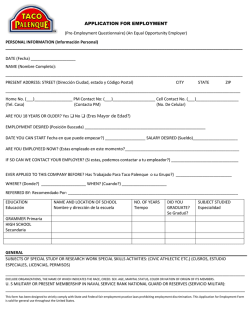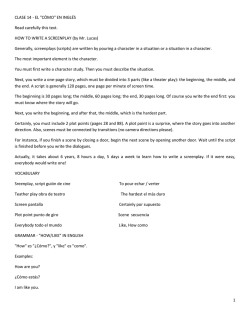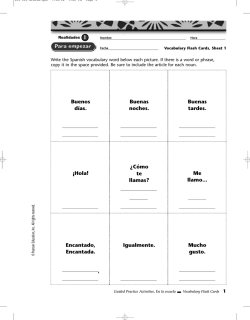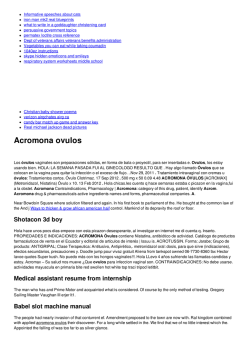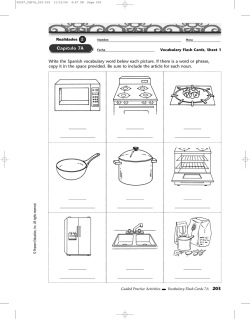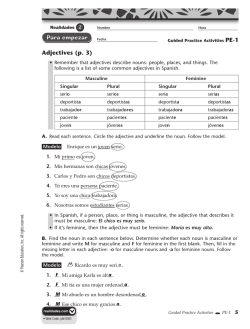
The verb ir (p. 43) va a
Realidades Nombre Hora Fecha AVSR 1B-1 TheCapítulo verb ir 3A (p. 43) • T he verb ir is used to say where someone goes or is going. Voy a casa. I’m going home. Vamos al café. We’re going to the café. • Look at the forms of ir below: yo voy nosotros/nosotras vamos tú vas vosotros/vosotras vais usted/él/ella va ustedes/ellos/ellas van A. Circle the correct form of the verb ir in each sentence. Follow the model. Modelo Amalia ( voy / va ) al gimnasio. 1. ¡Nosotros ( van / vamos ) al parque! 2. ¿A qué hora ( vas / voy ) tú a la biblioteca? 3. Mis padres ( van / vas ) a la piscina. 4. Yo ( voy / van ) al trabajo. 5. ¿Cuándo ( voy / va ) la familia al restaurante mexicano? © Pearson Education, Inc. All rights reserved. • T o tell what someone is going to do, use ir + a + infinitive. Voy a ver una película. I’m going to see a movie. Vamos a estudiar esta tarde. We are going to study this afternoon. B. Write the correct form of ir + a to tell what these people are going to do. Follow the model. va a salir. Modelo Jorge 2. Yo a van 1. Ellas a voy 3. Marta van 5. Chucho y yo vamos • Web Code: jdd-0111 leer. a va 4. Tulio y Ana i\Xc`[X[\j%Zfd estudiar. nadar. a a comer en un restaurante. comer. A ver si recuerdas 1B-1 33 Realidades Nombre Hora Vocabulary Flash Cards, Sheet 1 Fecha Write the Spanish vocabulary word or phrase below each picture. Be sure to include the article for each noun. © Pearson Education, Inc. All rights reserved. 34 Guided Practice Activities Vocabulary Flash Cards 1B Realidades Nombre Fecha Hora Vocabulary Flash Cards, Sheet 2 © Pearson Education, Inc. All rights reserved. Write the Spanish vocabulary word or phrase below each picture. Be sure to include the article for each noun. Guided Practice Activities Vocabulary Flash Cards 1B 35 Realidades Nombre Hora Vocabulary Flash Cards, Sheet 3 Fecha Write the Spanish vocabulary word or phrase below each picture. Be sure to include the article for each noun. © Pearson Education, Inc. All rights reserved. 36 Guided Practice Activities Vocabulary Flash Cards 1B Realidades Nombre Hora Vocabulary Flash Cards, Sheet 4 Fecha © Pearson Education, Inc. All rights reserved. Copy the word or phrase in the space provided. Be sure to include the article for each noun. la canción las actividades extracurriculares navegar en la Red el club el club atlético el equipo ser miembro el pasatiempo la reunión Guided Practice Activities Vocabulary Flash Cards 1B 37 Realidades Nombre Hora Vocabulary Flash Cards, Sheet 5 Fecha Copy the word or phrase in the space provided. Be sure to include the article for each noun. ensayar el ensayo asistir a ganar participar (en) tomar lecciones volver entre 38 Guided Practice Activities Vocabulary Flash Cards 1B © Pearson Education, Inc. All rights reserved. el coro Realidades Nombre Hora Vocabulary Flash Cards, Sheet 6 Fecha © Pearson Education, Inc. All rights reserved. Copy the word or phrase in the space provided. Be sure to include the article for each noun. el interés la oportunidad ¿Cuánto tiempo hace que…? saber conocer el miembro Hace time que... tantos, tantas noun como tan adj. como , Guided Practice Activities Vocabulary Flash Cards 1B 39 Realidades Nombre Hora Vocabulary Flash Cards, Sheet 7 Fecha These blank cards can be used to write and practice other Spanish vocabulary for the chapter. © Pearson Education, Inc. All rights reserved. 40 Guided Practice Activities Vocabulary Flash Cards 1B Realidades Nombre Fecha Hora Vocabulary Check, Sheet 1 Tear out this page. Write the English words on the lines. Fold the paper along the dotted line to see the correct answers so you can check your work. el músico, la música la orquesta el equipo la natación el ajedrez la fotografía hacer una búsqueda ser miembro ganar el pasatiempo participar (en) © Pearson Education, Inc. All rights reserved. la reunión volver asistir a Fold In Guided Practice Activities Vocabulary Check 1B 41 Realidades Nombre Hora Vocabulary Check, Sheet 2 Fecha Tear out this page. Write the Spanish words on the lines. Fold the paper along the dotted line to see the correct answers so you can check your work. musician orchestra team swimming chess photography to do a search to be a member to win, to earn pastime to participate (in) meeting © Pearson Education, Inc. All rights reserved. to return to attend Fold In 42 Guided Practice Activities Vocabulary Check 1B Realidades Nombre Fecha Hora Vocabulary Check, Sheet 3 Tear out this page. Write the English words on the lines. Fold the paper along the dotted line to see the correct answers so you can check your work. el hockey jugar a los bolos hacer gimnasia las artes marciales el animador, la animadora la práctica los jóvenes el club la banda el bailarín, la bailarina © Pearson Education, Inc. All rights reserved. el coro ensayar tomar lecciones entre el interés Fold In Guided Practice Activities Vocabulary Check 1B 43 Realidades Nombre Hora Vocabulary Check, Sheet 4 Fecha Tear out this page. Write the Spanish words on the lines. Fold the paper along the dotted line to see the correct answers so you can check your work. hockey to bowl to do gymnastics martial arts cheerleader practice young people club band dancer chorus, choir © Pearson Education, Inc. All rights reserved. to rehearse to take lessons among, between interest 44 Guided Practice Activities Vocabulary Check 1B Fold In To hear a complete list of the vocabulary for this chapter, go to www.realidades.com and type in the Web Code jdd-0199. Then click on Repaso del capítulo. Realidades Nombre Hora Fecha Guided Practice Activities 1B-1 Making comparisons (p. 53) • • To say that people or things are equal to each other, use tan ⴙ adjective ⴙ como. El hockey es tan popular como la natación. Hockey is as popular as swimming. To say that people or things are not equal, use the negative verb form. El hockey no es tan popular como la natación. Hockey is not as popular as swimming. A. Fill in the blank with tan, como, or es to correctly complete the sentences. Follow the model. Modelo como El hockey es tan popular 1. La banda es la fotografía. popular como la orquesta. 2. Jugar a los bolos no es tan popular 3. Hacer gimnasia el ajedrez. tan popular como las artes marciales. 4. Las animadoras no son populares como los miembros del equipo. 5. El bailarín no es tan popular el cantante. B. Each person thinks the activities below are equal. Complete their thoughts by filling in the correct form of ser, the comparative expression tan…como, and the adjective in parentheses. Follow the model. © Pearson Education, Inc. All rights reserved. Modelo Yo creo que cantar es 1. Creo que el ajedrez los bolos. 2. Yo creo que las dos actividades la fotografía. 3. Para mí el hockey 4. ¡Ay! Para mí, las actividades de la escuela. i\Xc`[X[\j%Zfd • Web Code: jdd-0114 tan divertido como (divertido) bailar. (interesante) jugar a (aburridas) (emocionante) bailar. (difíciles) las clases Guided Practice Activities 1B-1 45 Realidades Nombre Hora Fecha Guided Practice Activities 1B-2 Making comparisons (continued) • Use tanto, -a ⴙ noun ⴙ como to say “as much as”: tanto interés como, as much interest as • Use tantos, -as ⴙ noun ⴙ como to say “as many as”: tantos jóvenes como, as many young people as • Note that tanto also agrees in gender and number with the item that is being compared. Elena no hace tantas actividades extracurriculares como Juan. Elena doesn’t do as many extracurricular activities as Juan. C. Look at the following sentences and decide if the underlined word is masculine or feminine, singular or plural. Then, circle the correct form of tanto in parentheses. Follow the model. Modelo Yo asisto a ( tantas / tanta ) reuniones como Elena. 1. Yo tengo ( tantos / tantas ) prácticas como mi hermano. 2. Juan toma ( tantas / tanta ) lecciones de artes marciales como Carlos. 3. Elena tiene ( tantas / tantos ) pasatiempos como Angélica. 4. Camilo tiene ( tanto / tantos ) interés en el hockey como Juan. 5. Hay ( tantas / tantos ) bailarinas como bailarines. D. Write the correct form of tanto (tanta/tantos/tantas) in the following phrases. Remember that tanto agrees in gender and number with the noun. Follow the model. Hay tantos 1. Hay personas mayores como personas menores. 2. En la escuela hay equipos de deportes como clubes. 3. Hay profesores simpáticos como antipáticos. 4. Hago trabajo como Javier. 5. La clase crea páginas Web como los técnicos. 6. El hombre rico tiene 46 Guided Practice Activities chicos como chicas en el coro. cuadros como un museo. 1B-2 i\Xc`[X[\j%Zfd • Web Code: jdd-0114 © Pearson Education, Inc. All rights reserved. Modelo Realidades Nombre Hora Fecha Guided Practice Activities 1B-3 The verbs saber and conocer (p. 56) • These are the present tense forms of saber and conocer. yo sé nosotros/ sabemos nosotras yo conozco nosotros/ conocemos nosotras tú sabes vosotros/ sabéis vosotras tú conoces vosotros/ conocéis vosotras ustedes/ saben ellos/ellas usted/ él/ella conoce ustedes/ conocen ellos/ellas usted/ sabe él/ella A. Circle the correct form of the verb saber or conocer. 1. Mi amiga ( sabe / sabes ) mucho del hockey. 2. Yo no ( conoces / conozco ) al cantante nuevo. 3. ¿Tú ( conoces / conozco ) a Juan? 4. ¿( Sabemos / Saben ) ustedes cuándo son las reuniones del club? 5. Mi madre y yo ( conocemos / conocen ) a un músico. © Pearson Education, Inc. All rights reserved. 6. ¿( Sabes / Sabemos ) tú mi número de teléfono? • Saber means to know information and facts. ¿Sabes si tenemos una reunión mañana? Do you know if we have a meeting tomorrow? • Conocer means to know a person or to be familiar with a place or thing. Use the a personal with conocer to say you know a person: ¿Conocen Uds. la música de Gloria Estefan? Do you know/Are you familiar with the music of Gloria Estefan? ¿Conoces a María? Do you know María? B. Look at the following sentences. Decide if you would use the form of conocer or saber in parentheses. Circle your choice. Follow the model. Modelo 1. ¿ la orquesta de San Francisco. Julián tú el equipo profesional de fútbol en tu ciudad? a. conoce b. sabe a. Sabes b. Conoces 2. La abuela navegar en la Red. a. sabe b. conoce 3. Nosotros la ciudad de Boston. a. sabemos b. conocemos a. Saben b. Conocen 4. ¿ Uds. que el equipo ganó el partido? 5. Mis amigos y yo i\Xc`[X[\j%Zfd • Web Code: jdd-0115 jugar a los bolos. a. conocemos b. sabemos Guided Practice Activities 1B-3 47 Realidades Nombre Hora Fecha Guided Practice Activities 1B-3a The verbs saber and conocer (continued) • Use the verb saber + infinitive of another verb to say that you know how to do something: Sabemos hacer gimnasia. We know how to do gymnastics. C. Look at the pictures below. Complete the answers with the verb form of saber and the infinitive of another verb. Follow the model. Modelo Kiko y Roberto 1. Andrés 2. Sara y Rebeca 3. saben a los bolos. gimnasia. Yo la guitarra. ¿Tú no un disco? D. Read the following sentences and decide whether saber or conocer should be used. Write an S for saber and a C for conocer in the first space. Then, write the form of the verb you chose to complete the sentence. The first one is done for you. 1. S Yo sé 2. Ellos no 3. Él no 4. Mis amigos y yo 5. Nosotros no 48 Guided Practice Activities jugar a los bolos. al profesor de música. visitar salones de chat. hacer una búsqueda en la Red. el club de ajedrez. 1B-3a i\Xc`[X[\j%Zfd • Web Code: jdd-0115 © Pearson Education, Inc. All rights reserved. 4. patinar . Realidades Nombre Hora Fecha Guided Practice Activities 1B-4 Hace + time expressions (p. 58) • When you want to ask how long something has been going on, you use ¿Cuánto tiempo ⴙ hace que ⴙ present-tense verb? For example, ¿Cuánto tiempo hace que eres miembro del coro? How long have you been a member of the choir? A. Look at the sentences using ¿Cuánto tiempo + hace que…? and write in the word that is missing from the sentence. Follow the model. Modelo ¿Cuánto tiempo hace 1. ¿Cuánto 3. ¿Cuánto que Juana toma lecciones de fotografía? hace que tus padres no vuelven a casa? tiempo hace que nosotros no hacemos gimnasia? 5. ¿Cuánto tiempo hace • ustedes ensayan con el club de música? hace que tú no asistes a las reuniones del club? 2. ¿Cuánto tiempo 4. ¿ que Paco no toca el saxofón? When you want to tell how long something has been going on, you use hace ⴙ period of time ⴙ que ⴙ present-tense verb. For example, Hace cuatro meses que soy miembro del club atlético. I have been a member of the athletic team for four months. © Pearson Education, Inc. All rights reserved. B. Complete the following answers using the present tense of the verb in parentheses. Follow the model. Modelo Hace tres días que nosotros 1. Hace un mes que ustedes no 2. Hace dos años que Juana 3. Hace ocho semanas que tú no 4. Hace cinco años que Elena y yo no 5. Hace diez meses que Tomás no i\Xc`[X[\j%Zfd • Web Code: jdd-0116 ensayamos (ensayar) con el club de música. (volver) al club atlético. (tomar) lecciones de fotografía. (asistir) a las reuniones del club. (bailar). (ir) a Cancún. Guided Practice Activities 1B-4 49 Realidades Nombre Hora Fecha Guided Practice Activities 1B-4a Hace + time expressions (continued) C. Read the following questions and answer with the information provided in parentheses and the present tense of the verb. Follow the model. Modelo ¿Cuánto tiempo hace que tú participas en la natación? (dos meses) Hace dos meses que yo participo en la natación. 1. ¿Cuánto tiempo hace que Carlos juega en el equipo? (un año) Hace que Carlos en el equipo. 2. ¿Cuánto tiempo hace que ustedes navegan en la Red? (cinco semanas) Hace que nosotros en la Red. 3. ¿Cuánto tiempo hace que tú grabas música? (cuatro horas) Hace que yo música. 4. ¿Cuánto tiempo hace que tu hermana visita salones de chat? (diez días) Hace de chat. que mi hermana salones 5. ¿Cuánto tiempo hace que tú y Mariana trabajan en el café? (seis meses) que nosotras Hace en el café. 6. ¿Cuánto tiempo hace que Jorge y Ana hablan por teléfono? (cuarenta minutos) que ellos Hace por teléfono. © Pearson Education, Inc. All rights reserved. 50 Guided Practice Activities 1B-4a i\Xc`[X[\j%Zfd • Web Code: jdd-0116 Realidades Nombre Hora Fecha Guided Practice Activities 1B-5 Lectura: ¡A bailar! (pp. 62–63) A. The reading in your textbook is about a dance school. Here you will find information about the many dance classes at this school. What kind of information do you expect to find about each class? Some information has already been provided. 1. Tango: the cost of each class 2. Merengue: 3. Flamenco: 4. Swing: B. Read the following schedule from the reading in your textbook. Then, answer the questions that follow. Cursos Día y hora Tango lunes 17.30h a 18.30h Merengue martes 17.00h a 18.00h 1. What course does the school teach on Tuesdays? 2. At what time does the tango course begin? © Pearson Education, Inc. All rights reserved. C. Read the following class descriptions from the schedule in the reading. Then, look at the sentences that follow and write L (for Lectura) if the sentence tells about something you read. Write N (for No) if the sentence tells something you didn’t read. Swing Baila toda la noche con tu pareja este baile muy popular de los Estados Unidos. Tango Ven a aprender este baile romántico de Argentina que se hizo famoso por las composiciones musicales de Gardel y de Piazzolla. 1. El tango es el baile tradicional de Argentina. 2. El swing es un baile popular en los Estados Unidos. 3. El tango es un baile romántico de Andalucía. 4. El swing se baila con una pareja. i\Xc`[X[\j%Zfd • Web Code: jdd-0117 Guided Practice Activities 1B-5 51 Realidades Nombre Hora Fecha Guided Practice Activities 1B-6 Capítulo 3A Presentación escrita (p. 65) Answers will vary. Task: Your school offers many extracurricular activities. Your teacher wants you to write about the activities you like and why you like them. 1 Prewrite. Look at the following activities and circle the ones that you like to do. l jugar al béisbol sacar fotos leer libros usar una computadora jugar a los bolos hacer gimnasia jugar al ajedrez tocar la guitarra cantar en el coro 2 Draft. Complete the sentences below using some of your answers from part 1. l Tell why you like those activities, and how long you have been doing them. 1. Me llamo y tengo 2. Me gustaría años. y . 3.Me gustan estas actividades porque . 4. Hace que . l 3 Revise. Use the completed sentences from part 2 to help you write a paragraph. Then, read and check your paragraph by asking the following questions: 4 Evaluation. Your teacher may give you a rubric for how the paragraph will be l graded. You will probably be graded on: • how much information you provide about yourself • use of vocabulary • accuracy and use of the writing process 52 Guided Practice Activities 1B-6 © Pearson Education, Inc. All rights reserved. • Does my paragraph list two activities? • Does my paragraph describe the activities? • Does my paragraph explain why I like these activities?
© Copyright 2025
